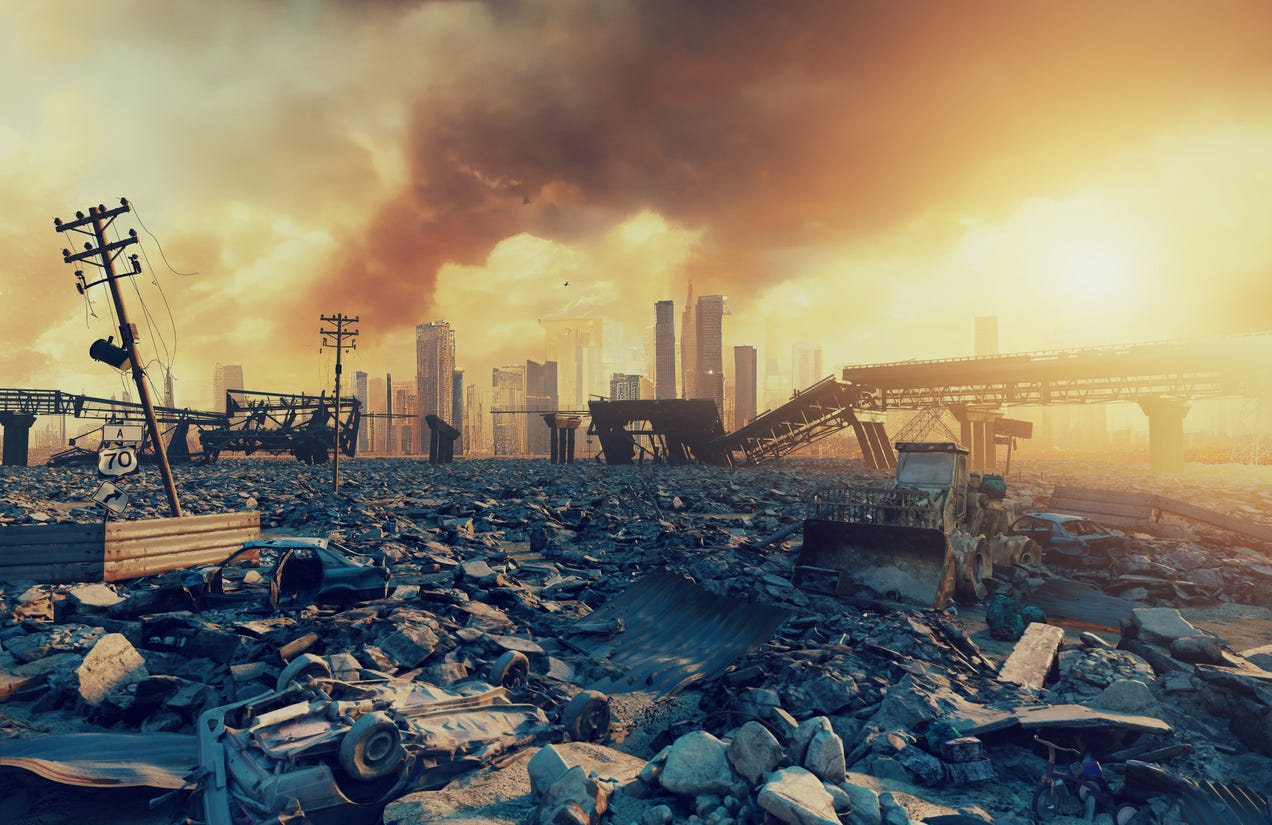original source | January 2023
Danilo Brozović is an Associate Professor at the University of Skövde, Sweden. In this paper, published in the peer-reviewed journal Futures, Danilo attempts to consolidate and synthesize a wide range of multidisciplinary research on societal collapse. The paper identifies theoretical tensions and themes in extant research, and indicates potential research that can follow from his findings.
Abstract
Because of concerns that ongoing climate change could lead to a possible collapse of human civilization, the topic of societal (civilization) collapse has emerged as especially relevant, not least for the futures-oriented studies. While this has led to extensive research on societal collapse, there is a lack of consolidation and synthesis of the research. The purpose of this article is thus to systematize the extant research on societal collapse and suggest future research directions.
This article offers a systematic multidisciplinary review of the existing literature (361 articles and 73 books) and identifies five scholarly conversations: past collapses, general explanations of collapse, alternatives to collapse, fictional collapses, and future climate change and societal collapse. The review builds the foundation for a critical discussion of each line of inquiry by focusing on theoretical tensions and themes within each scholarly conversation, ending with a discussion of how these conversations inform futures research.
READ THE FULL PAPER: HERE
Implications, future research directions, and discussion
The results of the literature review largely confirm this fragmentation and demarcation between studies on past collapses and possible future collapse. The fragmentation and demarcation are visible in the overlaps between the categories in the classification of the identified publications (see Appendix 2) and are supported by the results of the bibliometric study (Appendix 3). Most of the existing overlaps occur between the first three conversations, which dominantly studied past collapses, and between the fourth and fifth, interested in possible future collapse. However, despite this demarcation, there are some influential publications arguing that lessons from past collapses may inform societal transformation in light of future climate change and societal collapse. For example, Costanza et al. (2007) argued that the integration of records of how human-environment systems co-evolved over time is needed to provide a basis for a deeper understanding of the present and for forecasting the future. Likewise, Diamond’s (2005) framework of collapse factors was developed based on the insights from past collapses, but included considerations about future climate change and collapse, and Tainter and Taylor’s (2014) reflections on Tainter’s (1988) complexity theory applied to the modern world are also influential studies. Nevertheless, studies attempting to use insights from past collapses to inform possible future collapse are surprisingly scarce, in relative terms, although they have the potential to be influential. This relative scarcity is even more surprising because many publications about past collapses in their problematization present the argument that more knowledge about a particular past collapse in which they are interested might provide insights for future climate-change-related challenges. However, they rarely follow up on this argument in the results. For example, Mensing et al., (2013, p. 122) stated that “[a] more complete understanding of how both natural and human-caused changes have affected the environment in the past can potentially guide policy decisions aimed at promoting future sustainability,” but did not connect their results to this statement.
Thus, there is more potential to develop highly relevant research focusing on how insights from past collapses could inform research on future climate change and societal collapse. For example, Cumming and Peterson (2017) identified 14 mechanisms of collapse of past societies and used them to reflect on the need to increase the resilience of the global socioecological system in particular areas. However, they simultaneously expressed their reservations against this approach, stating that the analyses of historical collapses may not offer relevant insights for contemporary society because of recent human developments and the specificities of the modern socioecological system (Cumming & Peterson, 2017). In performing such research, one must acknowledge that earlier collapses were societal, local, regional, and civilizational in nature, but that the possible future collapse—or decline—is global, presenting an existential threat to humanity and the planet (Young et al., 2006, Sardar, 2021). However, exploring historical collapses, their aftermath, and the resilience of past societies may provide valuable lessons for local, marginal environments facing hydroclimate change, overpopulation, and scarcity of resources (Nicoll & Zerboni, 2020) and should, therefore, not be dismissed. This literature review showed several influential voices exhibiting that such cross-pollination is possible, even on a more general level (Diamond, 2005, Costanza et al., 2007, Tainter and Taylor, 2014).
Another intriguing finding of this review has been the fourth conversation about fictional collapses. Although the most modest measured by the number of publications, it offered some interesting insights for future studies. For example, the review has indicated the importance of fiction and narratives in strengthening the human spirit, but also its potential to guide societal transformation. An example of an SF-writer concerned with how climate change might affect humanity and how global society responds to associated challenges is Kim Stanley Robinson. His novel The Ministry for the Future (Robinson, 2020) presents an idea of the eponymous body advocating for the rights of future generations. The novel is scientifically accurate, also, when it described history and social sciences, and future events are told from the perspectives of various characters expressing their views on ecology, climate, and other issues relevant in the context (Poole, 2020). Such narratives may help in navigating through the future.
There is also an overlap between the fourth conversation’s discussion about how fictional narratives could influence social and public opinion in a more negative manner (see ecocriticism by Schneider-Mayerson et al., 2020) and the fifth conversation’s theme concerning emotional responses to future climate change (e.g., Baker, 2009). This overlap represents a promising and relatively unexplored research avenue, with the future research potential even more pronounced if contemporary fictions from certain past collapses or fictional works about past collapses are included in such studies, such as contemporary works from and/or novels about the late Roman Empire and the narratives existing in them. Studying narratives in works of nonfiction, as in Randall (2016), is also promising, especially the characteristics of the optimistic narrative opposed to the narrative of “climate alarmism.”
Although research streams on societal collapses exhibit heterogeneity, some common denominators of studies on past collapses and studies on future climate change and societal collapse can be recognized. Thus, societal response in the face of collapse is crucial; more concretely, the most valuable lessons are that a society should transform its institutions, change policies and politics, and increase resilience in areas such as food production and biodiversity in order to mitigate collapse. These insights appear regardless of the conversation or the focus on the past or the future. Indeed, how societies react when confronted with a crisis proved most crucial in avoiding or mitigating an environmental-change-related collapse (Coombes and Barber 2005). The last several years have seen an increase in climate-change-related effects on human society and the global economy, not the least of which were the recent pandemic, floods, wildfires, and droughts. In light of these and potential further effects, transforming the current global society emerges as necessary; the literature offers many suggestions, indicated in the associated theme in the fifth conversation (e.g., Odum & Odum, 2001; Meadows et al., 2004; Gowdy, 2020; Paterson, 2020).
Some of the literature assumed that the negative effects of climate change will increase in the future, arguing that global society should adapt to such effects (Bendel and Read, 2021). Diamond (2005) also wrote that a future collapse might not entail an apocalyptic collapse of industrial civilization, but “just” a future of significantly lower living standards, chronically higher risks, and the undermining of what we now consider some of our key values. He underlined the worldwide spread of diseases or wars, triggered by a scarcity of environmental resources, as manifestations of such a future collapse. In their interesting article combining the first and the fifth conversation, Gunn et al. (2019) pointed out how the Classic Maya collapse may imply that necessary transformations of global societies probably will occur because of the scale of disruptions, but that they would likely lead to social disruptions.
Increasing resilience in global society has also emerged as necessary, as another lesson from past collapses (Yoffee and Cowgill, 1988, McAnany and Yoffee, 2009, Schwartz and Nichols, 2010), both to mitigate collapse and to minimize its effects if it becomes inevitable. Table 3 indicated several research directions that can be utilized to that end. For example, studying highly resilient societies that have never experienced collapse (Diamond, 2005), as well as systematic modeling combining climate change with the sociopolitical processes thought to drive collapse, may provide valuable guidance. The application of Turchin et al.’s (2013) study on modern global society can also be intriguing. In any case, one manner of increasing resilience is through innovation (Tainter, 1988). Taking into consideration both the opponents and proponents of technological innovation as a means to confront collapse, it is reasonable to assume that innovations are necessary to mitigate the immediate negative effects of climate change. However, observing this insight through Tainter, 1988, Tainter, 1995 complexity theory lens, continued increases in complexity of the global society merely postpone, and do not mitigate, collapse. Thus, innovation should probably not be accepted as the ultimate remedy to the situation (Butler, 2016), but rather, soundly skeptical, as a means that buys humanity time to profoundly transform society in a more sustainable direction.
However, the review has also indicated that such transformations may have inherent pitfalls. Future research bringing more understanding to why the collapse template repeats, why past societies failed and did not learn from previous mistakes, and what the possible causes of the rigidity of our global system might be can help in mitigating the pitfalls. Some examples of pitfalls indicated in the review have been social hubris (Middleton, 2017b) and technological utopia (Gómez-Baggethun, 2020), as well as the tendency of societies to make decisions based on past investments rather than on future returns (Janssen & Scheffer, 2004). Another interesting insight is the role of chance, or randomness and luck, in overcoming societal collapse. Several authors indicated this factor (Hadlock, 2012, Pugesek, 2014, Kemp, 2019), leading to the conclusion that a society may collapse even if it makes all the right moves, so to speak (Frank et al., 2018).
As it is, the future is highly uncertain, and models and predictions cannot provide simple answers to how it will unfold (Costanza et al., 2006). According to the authors, the purpose of any scenario, consequently the ones shown in this literature review as well, is to create utopias that guide appropriate responses to changes in the environment.
READ THE FULL PAPER: HERE



